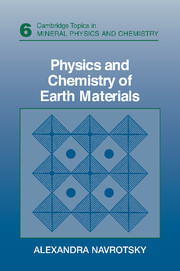Book contents
- Frontmatter
- Contents
- Acknowledgments
- 1 Introduction
- 2 Crystal chemistry
- 3 Experimental methods for studying structure
- 4 Methods for studying thermodynamic properties
- 5 Chemical bonding
- 6 Mineral thermodynamics
- 7 Solid solutions and order–disorder
- 8 Melts, glasses, and amorphous materials
- 9 The interface between mineral physics and materials science
- Index
- Frontmatter
- Contents
- Acknowledgments
- 1 Introduction
- 2 Crystal chemistry
- 3 Experimental methods for studying structure
- 4 Methods for studying thermodynamic properties
- 5 Chemical bonding
- 6 Mineral thermodynamics
- 7 Solid solutions and order–disorder
- 8 Melts, glasses, and amorphous materials
- 9 The interface between mineral physics and materials science
- Index
Summary
Minerals, naturally occurring solid-state compounds, form the firm earth under our feet, the hard rocks that make up continents, the ores of commercial importance, and the inaccessible depths of the earth and other planets. Mineralogy and crystallography have long been linked both esthetically, because many minerals occur as beautiful crystals, and intellectually, because the periodic arrangement of atoms in a crystal provides the fundamental explanation for all mineral properties. Indeed, elucidating crystal structures has been the main business of mineralogy for fifty years, from the first X-ray diffraction experiments around 1910 to the automation of diffraction techniques that came with the first small computers in the late sixties. This technological development spelled both the end and the beginning of an era. The end came in the sense that solving or refining a crystal structure no longer represents a laborious task in itself worthy of an advanced degree. The beginning was, and is, the opportunity to use crystallography as a tool, often in a comparative sense, to study many related structures and how they vary with imposed constraints of pressure, temperature, and composition. X-ray crystallography can now be used in combination with other emerging structural techniques such as neutron diffraction and electron microscopy, with spectroscopic studies, and with work on phase equilibria and thermochemistry. Crystallography and many spectroscopic tools have been rejuvenated by access to much higher intensity sources of radiation, such as those provided by synchrotrons.
- Type
- Chapter
- Information
- Physics and Chemistry of Earth Materials , pp. 1 - 6Publisher: Cambridge University PressPrint publication year: 1994
- 1
- Cited by



